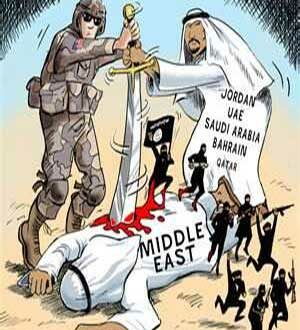Since 1943, the Americans have not looked back. Throughout the 1950s and 1960s, American companies paid whatever they felt like for a barrel of oil. In August 1960, for instance, Monroe Rathbone, the chief executive officer of Esso, today’s Exxon, unilaterally decided to slash the price his company would pay to oil producers from $2 to $1.80. The Organization of Petroleum Exporting Countries (OPEC) did not exist then. Even so, for two years after it was formed on September 9, 1960, the Americans refused to recognize or deal with it. But America’s interest in Saudi Arabia was not confined to oil alone. As successor to Britain’s mantle as superpower, America now took it upon itself to police the world. And among all its clients, Saudi Arabia held the key to controlling the Muslim world because of the Haramayn — the two holy places of Islam — as the British had realized before the turn of the century.
Production of oil brought American technicians and “advisors” in its wake. Later, the US military also joined in. Saudi princes were flown to America and introduced to the American version of modernization and corruption. So impressed were the Saudis by the American way of life that they began to import everything from the US, including sand. Concrete jungles began to sprout in the middle of the desert, much like the monstrosities that the Americans have created in New York, Chicago or Houston. The Saudis couldn’t pay fast enough to import these American-style cities to their land awash in oil wealth.
Saudi Arabia’s importance in the US scheme of things would have declined but for two developments that forced a re-evaluation in US thinking. One was the OPEC price-hike of October 1973 after the limited war that Egypt and Syria fought against the Zionist State. The other, more serious, was the success of the Islamic Revolution in Iran in February 1979. The successive wars between the Arabians and the Zionists were designed to drive home the point to the Arabians that Israel was an “invincible power” and unless the Arabs came to terms with it, they would lose even more. Along the same lines, the Americans wanted to use the Saudis to break the power of OPEC. The manner in which the price of oil crashed from a high of nearly $36 per barrel in 1981 to almost $10 at the beginning of 1987 was achieved primarily through the Saudis.
The wars of June 1967 and October 1973 between the Arabians and the Zionists were designed to pave the way for the Arabian rulers’ surrender to Israel. The Arabians’ temporary and limited victory in October 1973 was conceded in order to redeem some of their lost honour. Anwar Sadat’s dramatic visit to Jerusalem in November 1977, exactly 60 years after Balfour’s infamous declaration, was a confirmation of the Muslims’fate as a defeated people. But the uprising against the Shah in 1978 and the victory of the Islamic Revolution in Iran in February 1979 badly upset these American designs for the world of Islam. In their arrogance, however, they thought that the Islamic Revolution will prove another temporary phenomenon, much like the Algerian revolution or Nasser’s nationalist eruption in Egypt.
The Saudi role too has undergone a curious transformation. Nasser was viewed by the Saudis with great apprehension because of his revolutionary rhetoric. The Ba‘th Party, in Iraq and Syria, was an even more extreme mutant of the kind of nationalism espoused by Nasser. Thus, the Saudis always felt threatened by Ba‘thism. This led them into a close working relation with the Shah of Iran, another US client in the region, against the radical Ba‘thists who were aligned with the Soviet Union. However, immediately after the success of the Islamic Revolution in Iran and the rise of Saddam Husain as the absolute dictator in Iraq, the Saudi policy changed radically. This was not the result of any softening of attitude on the part of Saddam; the change occurred in the perception of the House of Saud. When faced with the emerging power of Islam in Iran, the Saudis even became prepared to strike a deal with the hated Ba‘thists.
The West, especially the Americans, too did everything to destroy the fledging Islamic Republic. Internal uprisings, sabotage and assassination of leading figures of the Islamic Revolution were all part of a policy to bring the Islamic Republic to its knees. When everything else failed to shake the faith of the Iranian people in Islam, a full-fledged invasion was launched from Iraq. This invasion was supposed to destroy the Islamic Republic and replace it by a military dictatorship of America’s choosing. The Iraqi Ba‘thists were financed by their Arabian cohorts, armed by the Soviet Union, France, Britain and Romania and given political and military support and intelligence data by the US. For nearly eight years the Islamic State of Iran singlehandedly withstood the combined might of kufr relying only on Allah (swt) and their inner strength. Not only were the Ba‘thist invaders driven out of Iran but military operations were taken into Iraqi territory itself. Despite a contribution of more than $181 billion by the Arabian regimes to the Iraqi war effort, the Ba’thists failed to destroy the Islamic State.
The Saudis worked closely with the US in this conspiracy against Islam. The AWACS planes that were hurriedly sent to Saudi Arabia in early 1981 were designed not to protect Saudi oil fields but to gather intelligence data on Iran’s troop movements and pass it on to Iraq. Then in mid-1986, the US provided complete layout details of Kharg Island, Iran’s main oil-loading terminal in the Persian Gulf, for Iraq to attack. At the same time, the Saudis were asked to flood the market with oil. The plan was to destroy Iran’s oil export capability while the Saudis would make up the shortfall. Even prior to this, the Saudis together with the Kuwaitis had been pumping an extra 300,000 barrels of oil per day on behalf of Iraq. The oil war launched against Iran turned out to be more damaging for the Saudis and the Americans than Iran. Oil-producing states in the US such as Texas, Oklahoma and Louisiana suffered considerably as a result of the oil price crash.
1986 was a bad year for US President Ronald Reagan and America. First, the Iraqis lost Faw Peninsula to Iran in February 1986. It was followed by major Iraqi losses in Kurdistan. In November, news broke out of Reagan’s secret attempts to try to establish relations with the Islamic State of Iran. A team led by Reagan’s former national security advisor, Robert McFarlane, had tried to sneak into Iran carrying forged Irish passports. At first the US denied the story but when Iran’s Majlis speaker Hashemi Rafsanjani confirmed that the Americans had tried to establish a dialogue with Iran through the McFarlane visit, a crisis erupted in the White House. A number of senior Reagan aides had to resign or were fired.
America’s European allies were furious at being double-crossed: the US was secretly shipping arms to Iran while outwardly leading the drive to impose an arms embargo. The US’ Arabian allies felt even more let down. For years they had presented themselves as close allies of the US. This had also put many of these rulers at great personal risk with their own people. Yet, the US was secretly sending weapons to Iran. The Arabians took this as a great snub. But what could they do? They huffed and they puffed but then calmed down, hoping that the US would do something to redeem whatever little honour they had left.
The crisis in the Persian Gulf, the decision to flag Kuwaiti tankers and US sabre-rattling in early 1987 against Iran were designed to achieve two things: divert attention at home from what came to be called the Iran-Contra affair and to restore US credibility among its Arabian clients. The Arabian regimes and especially Saudi Arabia and Bahrain put their military bases and facilities at the disposal of the US for a showdown with Iran. The July 31, 1987 massacre of Iranian hujjaj in Makkah was part of this devilish plan to cast Iran in a bad light. Iran had to be“punished” not only for what it was or was not doing vis-à-vis the war, but because it had upset the US plan for the Arabian regimes’ surrender to Israel.
The Makkah massacre was an ingenuous plan in which America would emerge the winner regardless of the outcome. If the plan succeeded by turning the issue into a Shi‘i-Sunni conflict, then the US could claim to have the “support” of the “Sunni” Muslim world in its attack on Iran. If it failed, the Americans would disclaim any responsibility for it and let Saudi King Fahd bear the consequences.
Since the Makkah massacre and despite the vicious propaganda by the Saudi regime, the Muslim world’s attention has been focused on the question of the future of the Haramayn and the illegitimacy of the House of Saud as its “guardian.” Bob Woodward’s book, The Veil, has exposed the Saudis’ true nature and close involvement in the CIA’s dirty wars, their contribution to the Contras’ fund on behalf of the US and their assistance in the plot to assassinate Shaykh Seyyed Fadhlallah in Beirut in March 1985. It was Bandar bin Sultan who masterminded the plot to assassinate Shaikh Fadhlallah. Then CIA director, William Casey was part of the plot that failed because the Seyyed had left the masjid immediately after Salah al-Jumu‘ah and before the car bomb exploded.
The Saudis have undertaken other criminal activities on behalf of the US. They now stand exposed in the Muslim world not only as American agents but also as Zionist agents. Not even their paid agents are able to defend Saudi conduct in any forum. Most Muslims wish an end to this decrepit family and the cleansing of the sacred territory of the Arabian Peninsula from these polluters. Recent developments may perhaps hasten their downfall. It will come none too soon.

 Mouood Mouood English Edition
Mouood Mouood English Edition



